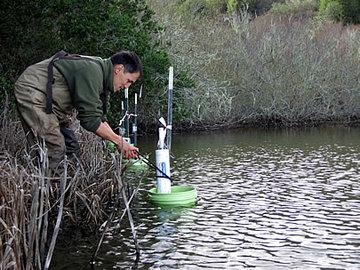The tiny fish called the tidewater goby doesn’t get the publicity that Death Valley’s Devils Hole pupfish gets, but like that other endangered little fish, this one is getting a helping hand from the National Park Service. Gobies from Point Reyes National Seashore were recently translocated to establish a new population in a protected lagoon on Tomales Bay.
The tidewater goby (Eucyclogobius newberryi) is a very small fish, rarely exceeding two inches in length. Evolution has left the goby with narrowly-defined habitat needs. The geographic distribution of this species is limited to the brackish waters of certain shallow shoreline lagoons, ponds, estuaries, and marshes along the California coast.
Unfortunately, a great deal of goby habitat has been destroyed or severely degraded by a combination of pollution, wetland draining and filling, sandbar breaching (for tidal flushing), and other factors. Since gobies commonly inhabit water bodies that are enclosed or blocked by sandbars, and aren’t equipped to migrate long distances through salty and turbulent ocean waters, it’s very difficult for them to colonize new habitat (or, for that matter, to enjoy the more diversified gene pool mixing that greater mobility offers). The US Fish and Wildlife Service has verified that gobies have disappeared from dozens of places they once occupied.
The plight of the goby has not gone unnoticed. In fact, the goby’s long-term prospects were deemed sufficiently grim to earn it protected status. Today the tidewater goby is both a state-listed (1987) and a federally-listed (1994) endangered species. This is a species that can certainly use all the help it can get.
Following the usual scientific studies and public vetting, the U.S. Fish and Wildlife Service put a tidewater goby recovery plan into place several years ago. In addition to protecting the goby’s critical habitat, the recovery plan emphasizes establishing new populations in suitable locations.
An outstanding example of this strategy at work occurred last month in Tomales Bay State Park adjacent to Point Reyes National Seashore. Thanks to the cooperative efforts of the National Park Service, the U. S. Fish and Wildlife Service, and the California Department of Parks and Recreation, 179 tidewater gobies from Point Reyes’ newly-restored Giacomini Wetlands were translocated to a protected lagoon in the state park, where they are expected to thrive and multiply.
You can read more about this translocation project at this site.
Postscript: It will be interesting to see whether and when translocation projects and related restoration efforts may improve the tidewater goby’s long-term prospects enough to warrant the removal of state and federal protection. Since the tidewater goby is a resilient species that’s thriving in various habitat pockets not likely to be lost or degraded, some scientists (and a lot of commercial development advocates) believe that the time to delist this species has already arrived.




Comments
Go gobys!